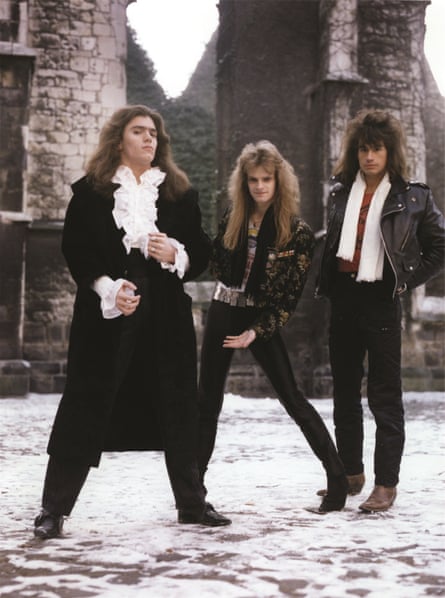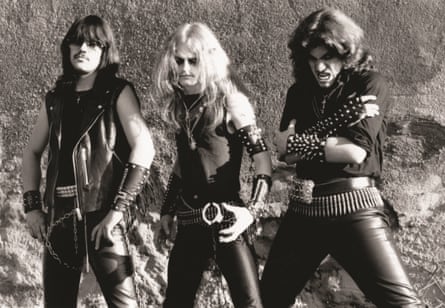Back in the 80s, the 4AD record label was synonymous with a certain ineffable otherness. Its albums had beautiful covers, designed by Vaughan Oliver, and inside those covers was music routinely described as “ethereal”. 4AD meant taste and taste meant 4AD.
Tom Fischer, a young Swiss man from a village outside Zurich, dreamed about his music one day appearing on 4AD. Dead Can Dance, who were signed to the label, were one of his favourite bands. His own music was extraordinary – string and horn sections clashing with electric guitars; female soprano voices countering untutored male vocals; a sense of freedom from boundaries – so why shouldn’t it have found a home among the independent avant garde?
For one, Fischer was not trying to sound like the Cocteau Twins. In fact, his own band sounded like nothing on 4AD. Fischer – better known as Tom G Warrior – was instead pushing the boundaries of metal further than anyone had yet taken them, and his group Celtic Frost would go down in history among the genre’s greatest pioneers. But that’s the nature of Warrior – he was the man who would never do what metal expected.
“The ambition exceeded the capabilities – by setting a goal that was almost unachievable, it forced us to go and achieve it,” he says now. “To work like maniacs to reach this. We had nothing else. We had nothing to lose. All bridges are burned, so all you have to do is go forward.”
The remarkable music Celtic Frost made between 1984 and 1987 is now gathered together in a massive box set – heavy both literally and musically – called Danse Macabre. Even now, it sounds more current than almost all other metal from that era. It displays the first crystallisation of extreme metal, where the sense of formal experimentation is every bit as important as grinding riffs. It still sounds brutally, thrillingly alive.
“They had a massive impact on heavy metal and black metal,” says Alter Bridge and Creed guitarist Mark Tremonti. “I think they’re one of the first black metal bands – but also to me, they’re one of the most influential of the early metal bands. The big difference was the creativity – in the moods, the chord progressions, the take on the vocals. Tom G Warrior has so many different personalities when he’s singing, and the moods that they set were just inspiring.”

Warrior didn’t have the happiest of childhoods, which came through in the music he made with his first band, the critically scorned Hellhammer (who nonetheless became a crucial influence on Norwegian black metal a few years later). Warrior sees Hellhammer songs, such as the desperately unpleasant Satanic Rites, as screams at his upbringing: “Now, looking back as a 59-year-old, I see the song is hatred directed against my mother, who furnished me with the youth I lived,” he says.
Celtic Frost was his attempt, with Hellhammer co-conspirator Martin Eric Ain, to move beyond the constraints of pure noise. “We quickly realised that Hellhammer was extremely limited, and if we wanted to use the term art we would have to completely reconfigure our musical approach. On the last day of May 1984 we sat together and throughout the night designed a new band from scratch, literally with pen and paper.”
That band was Celtic Frost. Everything about this new outfit was to be different. Warrior and Ain wanted it to have the power and excitement of the thrash metal bands emerging in the US, but the ultimate intent was to not be constrained by metal’s self-imposed rules – an attitude shaped by the band’s geographical isolation from the mainstream metal scene. “It was a constant conflict, because we loved metal. At the same time, however, we were conflicted by feeling that metal is so limited, that there were albums with notes saying: ‘No keyboards on this album’, and so on, like it was something evil,” he recalls. “We felt, where are these unwritten laws that say you cannot combine a keyboard with metal, or you cannot combine classical music with metal? We didn’t want to accept this. We were anarchists.”
The first Celtic Frost record, Morbid Tales, was ferocious and extreme. The second, To Mega Theiron, was a huge step forward. But the third, Into the Pandemonium, was the landmark – a dark and beautiful set that sounded like nothing else and confronted closed-minded metal fans by opening with a cover of Wall of Voodoo’s new wave hit Mexican Radio. Even the band name had been intended as a break from metal convention.
“Hellhammer, by the nature of its name, proclaimed ‘heavy metal’. There were bands like Slayer and Metallica, but given the concept of our new band, we wanted a name that left it open what we sounded like,” says Warrior. “Celtic Frost could also be a punk band or a new wave or a metal band. My mother said at the time, ‘It sounds like an aftershave.’ I could live with that.”
At first, Celtic Frost could not be a touring band, because they had no drummer. That changed with the arrival of an American expat going by the name of Reed St Mark, in February 1985, who had been told by a distributor of a young band out in the countryside looking for a drummer. “It was very daunting, because it was in a bunker bomb shelter,” St Mark says. “And I had not played heavy metal. I knew I was gonna have to play very powerfully, so I had some big marching sticks leftover from my youth, which I always carry just in case, and I said: ‘I’m just gonna blow these guys out of the water with sheer volume.’”
In the end giant sticks became a trademark – he would solo on stage with metre-long sticks he could barely lift – but he joined the band for the most prosaic of reasons: “Jazz was my passion. I started playing rock to put food on the table. So when the distributor said Celtic Frost had sold 15,000 units in the States, that got my attention.”
The strange thing is that while nobody would deny Celtic Frost’s importance now, at the time, the metal press was distinctly sniffy – especially Kerrang! “Morbid Tales got one out of five Ks,” Warrior says. “And it was ripped apart in the review. Whereas it’s one of the most important albums I’ve ever written. But we also understood Kerrang!’s approach, because it was the centre of the universe at the time.
“They dealt with people like Ronnie James Dio and David Coverdale, who were the sacred figures of the scene at the time. And then there were some underground bands who were just yelling – I could totally understand that they were alienated by bands like us initially. We could see where they came from, as blind as they were.”
That might not have been so much of a problem had Celtic Frost’s label, Noise, not felt the same way as Kerrang! Noise wanted a straight-ahead metal band, not an experimental art project, and Warrior feels the label did its best to sabotage the band during the making of Into the Pandemonium; as a result, the band fell apart.
By the time Celtic Frost got out of their contract, the Warrior-Ain-St Mark lineup was no more, and Warrior made “the gargantuan mistake” of pulling together a new lineup to make two more albums (1988’s Cold Lake and 1990’s Vanity/Nemesis) that he simply refuses to acknowledge any longer: “The final two albums of that period are really completely irrelevant, if not disastrous.”
But Celtic Frost live on, and Warrior these days is one of extreme music’s elder statesmen, rather than a lonely kid shouting out from the margins. And both Hellhammer and Celtic Frost now sit firmly in the pantheon of metal greats. “We had abandoned all fear, and we had abandoned all limits,” Warrior says. “We said: ‘If we are going this far, we might as well do whatever we want. Let’s be true artists and not think: you can’t do that.’
“This is why Celtic Frost is the band it is – and why Celtic Frost are still talked about many years after its demise.”

